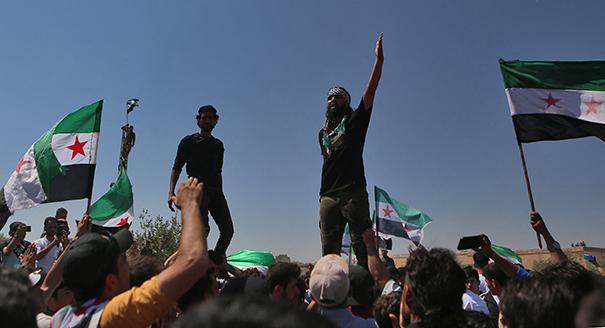In the years between 2013 and 2018, Syria’s conflict became more centered on the north of the country. In an arc stretching from Syria’s far northeastern areas to the far northwest, there emerged a series of areas outside the Assad regime’s control, including swathes of territory east of the Euphrates, large parts of Idlib Governorate, and military zones under Turkish military control. These were interspersed with pockets that remained under the authority of the Syrian state.
The border area, which had been a source of threat for the regime in the first years of the conflict, has today become a source of regional legitimacy. In the same way that opposition groups sought to secure border areas to be able to maintain contact with regional countries, while also exploiting lucrative crossborder trade when possible, the regime of President Bashar al-Assad now views the reestablishment of its rule over these borders as confirmation that it is a valid state actor, which would allow it to regain its standing in the region.
The Syrian-Turkish border remains indivisible, meaning that it forms a single political-security ecosystem, one connected to southern Turkey and regime-held Syria. Since the summer of 2012, two important developments have occurred there, shaping the present reality. First, opposition groups advanced on the city of Aleppo and took control of most of the areas east of it. This effectively connected those areas with more northernmost regions adjacent to the Turkish border. At the same time, regime forces withdrew from Amouda, Afrin, and Kobani, leaving them to the Democratic Union Party (PYD), which has ties to the Kurdistan Workers’ Party (PKK). Turkey considers the PKK a terrorist organization. With this, for the first time the border was used as a tool of war. Turkey provided support and assistance to Syrian opposition forces inside Syria, while the Assad regime gave a free hand to the PYD-PKK along Turkey’s southern border.
However, today the border is less of a gateway for the influx of weapons, fighters, and supplies to the Turkish-based opposition to the Assad regime, than a place where the interests of Ankara and Damascus intersect. The Turkish priority is to put an end to the autonomous status of Kurdish-dominated cantons inside Syria, while for the Assad regime, the principal aim is to reclaim those areas and extend its authority to the Turkish border.
What allowed the Syrian regime to impose itself as an interlocutor is that it was able to reinforce itself after the Russian military intervention in 2015. Syrian regime forces recaptured Aleppo in its entirety in 2016. This was followed by military operations and sieges in Syria’s central and southern regions, which fragmented the armed and civilian opposition. These military actions led to a series of local agreements that saw many opposition figures and their families, as well as other civilians, transferred to northern Syria. In addition, Russia, Turkey, and Iran launched the Astana and Sochi diplomatic tracks, which ended the opposition’s plan to topple the Assad regime. Regime change became unrealistic once Turkey was involved in these processes of negotiation.
Turkey’s rapprochement with the Assad regime appears to be developing and could lead to cooperation. On December 15, Turkish President Recep Tayyip Erdoğan announced that he had proposed to Russian President Vladimir Putin that Turkey and Russia establish a tripartite mechanism with Syria to accelerate a diplomatic opening to the Assad regime. Even if this is significant, normalization still remains elusive. The border includes complicated outstanding issues that could prove more intractable than the Syrian regime’s ability to deal with them.
In addition, the Syrian economy has deteriorated from a war economy into an economy of scarcity, while the regime is profoundly corrupt. Resources are limited, state institutions are almost totally paralyzed, and the black market has become the primary market. All of this has led to a new wave of displacement of young people and businessmen, who would be essential for reviving the country’s economy.
Demographics and security remain the biggest challenges for Damascus. Demographically, the war in Syria has displaced millions of people, many living in border areas and having ties with Syrians across the border. The regime will have to find a way for dealing with these communities. On the security front, developments in southern Syria are a good benchmark to evaluate the Assad regime’s postwar capacities. After the regime regained control of the south in 2018, the Syrian state—particularly its service-providing institutions, which have been among the biggest losers in the war—was unable to regain the initiative in Daraa Governorate. Rather, the task of local administration devolved to the country’s notorious military-security agencies. Compared with the northern border, the southern border is smaller and less complex, yet even there the regime has had to prioritize control over actual governance, with tentative results. That is why replicating such a system of control by the military-security agencies in the north is not possible. Demographics and security are intertwined along the northern border, and require an entirely different approach to what has happened in the south. This new approach would have to be based on a cohesive vision allowing the regime to transform its military victory into political gains.
Because the Syrian authorities are not in complete control of their borders, the Assad regime has been unable to operate successfully on the regional level. At the same time, the borders will not wait. The situation along Syria’s entire northern arc is changing. Until a settlement is reached that stabilizes the situation in the north, which could take years, the Assad regime will prefer to implement military solutions to regain control of more land, without advancing any postwar vision except one that ensures its survival for as long as possible.






